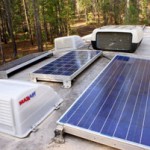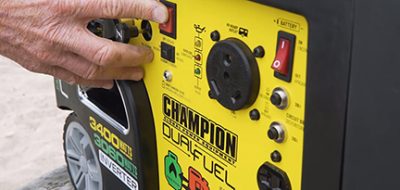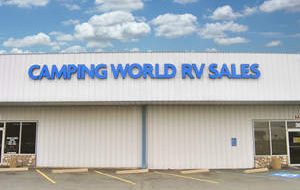Up until today, we have been exploring methods for providing campsite electrical power primarily from the sun and storage batteries. If you haven’t been reading the previous chapters on Campsite Power I encourage you to go back and review them before immersing yourself in this chapter. Without a basic understanding of storage batteries, solid state power inverters and the relationship between power and voltage you might find this chapter confusing.
They can be noisy, noxious, loved, and hated. I am referring to portable AC gasoline engine powered generators often carried and used by campers in areas where no electrical power is available.
For the moment, I am excluding installed RV generators such as the Cummins-Onan models often factory installed in motor homes. These are not “portable” with respect to this chapter.
There are two types of portable generators commonly available.
One is the synchronous generator that directly powers an AC alternator from the engine. These generators run at a constant speed of 3,600 revolutions per minute (RPM) to maintain the needed AC power frequency of 60 cycles per second, or in modern terms, Hertz (Hz). This class of generators is often mistakenly associated as having “dirty power” and being objectionably loud. We will discuss this type of generator next week in Chapter 6.
In this chapter, we are going to look at a class of generator commonly known as Inverter Generators.
Inverter generators operate on an entirely different principle than their synchronous cousins.
The generator engine drives a three-phase alternator (vs. single phase alternator on a synchronous generator) that generates power that is unusable as household power as generated. The three-phase power is fed into a solid state (no moving parts) inverter similar to what we reviewed in Chapter 4 that works directly off of a battery. This inverter converts the power from the alternator to useable 120-volt household power.
There are benefits to this type of generator over the synchronous models:
- They are usually smaller and weigh less.
- They are more fuel efficient.
- They are able to run their engines at slower speeds when power demands are low.
- The voltage produced by the inverter is less likely to have harmonic distortion.
- They can be quieter.
Generators in this class are commonly available with power outputs of 1,000 or 2,000 watts. This power rating is for short durations. Continuous power output is normally 20% lower than the advertised rating.
Inverter generators over 2,000 watts are available for powering RV air conditioners and large microwave ovens. You may also hook two smaller inverter generators together, combining their individual power output, to run larger current appliances. This has become a popular method since a single and obviously, a more fuel-efficient generator is all that is needed when not running an RV air conditioner.
The downside to an inverter generator is the purchase price when compared to synchronous models. They can cost two to four times more.
Two of the most popular models of inverter generators are manufactured by Honda and Yamaha. A 1,000-watt model is a preferred size for tent and pop-up campers. Those with trailers and small motor homes often prefer one providing up to 2,000 watts.
After dominating the inverter generator market for years, the Japanese models are being challenged by several quality products built in China. Champion Power Equipment of Santa Fe Springs, California builds one of these products.
Champion owns its own manufacturing facility in China. Their products are engineered and serviced by their United States facility.
Champion has built an excellent reputation for technical service, product quality and the availability of service parts should they be needed.
A few months ago I purchased two of the Champion 2,000 watt inverter generators along with the device needed to connect both of them together. After conducting some extensive side-by-side power testing and a comparison of noise levels with competing models from Honda, Kipor and Yamaha I was pleased to find that the new CPE 2000i performed as well as the competition. I have been extremely impressed with the CPE 2000i performance, design and build quality.
You must remember that I am an admitted “tool junkie”. I own several different models of portable generators built by both the Japanese and now Champion. I don’t need all of them, I just like to collect, dissect and evaluate them. I consider them part of my “Beanie Baby Collection”.
The Champion 2000i has an 80cc engine and sips fuel like a southern lady does her tea. It runs quietly at under 60 dba, a rating of sound pressure used to measure loudness. At a distance of 30 feet, the generator is no louder than a conversation between two campers. Using a single generator, I have been able to quickly recharge my batteries for night use, make a pot of coffee, run the microwave and Nancy’s handheld hair dryer (not all at the same time).
It stows away neatly in the side compartment of the camper or truck and at less than 50 pounds can be conveniently carried by one person.
The cost of the Champion 2000i is 30% to 40% less than the popular red and blue Japanese models with comparable performance and service-support.






jonathan atkins
I have bought a Yamaha EF2000i inverter generator to use with my TAB, but I’m not sure how to use it correctly.
First of all is it the correct type?
Do I simply connect it to the power inlet using the surge protector?
It came with battery connections. The marine battery on the TAB has bare posts that you find on say car batteries, but the connections are not big enough to fit on them. They do fit the power outlets which have the wires to power the TAB. Is it okay to charge the battery from the generator using these?
Hope someone can help.
Jonathan
tYwvL3n
400440 815619Hey! I
Thinker
Great review, but you fail to mention that the Honda generator has a fuel pump, the others do not, including Champion and Yamaha. Amazon sells an inexpensive fuel cap that allows a simple outboard motor fitting to screw in. With this, the Honda will give you endless runtimes — depending on the size of your outboard motor tank.
cody
thanks for your review, I really liked the chart with the sound decibel levels, I haven’t seen anything like that before and it really puts it into perspective for me. After this I’m definitely siding towards getting and inverter generator instead of a regular gas or diesel. It looks like all the models you suggested have good reviews too..thanks for the heads up, you’ve helped a lot 🙂
william pecchi
Do you know about the 3300Boily inverter generator. Unable to find much info.
Thanks,
Timothy Shively
I have a 2000W Honda and my MH has a Xantrex 2500 inverter. The Honda will not run the Xantrx because the Haonda does not have a strapped neutral to ground. Xantrex says they require the power supply to be ground/neutral strapped. Honda says if I strap the ground/neutral it will blow the inverter board. Honda says they built there Gen for the world market and the US is different. Xantrex says “that’s the way it goes” It will not work and they can’t make it work.
On my older MH the Honda worked fine but not on the Xantrex.
Do you know any way to make it work?
TJ Shively
8116 Ashgrove Dr.
Cincinnati, OH 45244
513-383-8946 cell
Duane Morris
Inverter generators are good since you’ll no longer be using a dynamo with a fuel engine to have a power or electricity all you need is a series of coil that will help you convert stored electricity into a usable voltages. You can make a quite efficient small alternator, But the con about this thing is that you cannot control the output voltage, so it is hard to use the output directly.
Tennesseesnowbird
I never really understood how an inverter generator worked. I don’t recall reading anything before that told me it had a 3-phase alternator before the electronic works. Isn’t the alternator in a typical car or truck 3-phase as well? That helps me to understand how my inverter genset can run at different engine speeds – just like my truck alternator. I’ve enjoyed reading your Camping Power series. You have given me a much better understanding of how all of this stuff works. You should put all of this in a RV handbook and sell it.
Tom Amos, The Tennesseesnowbird freezing my buns off in Florida. What happened to global warming?